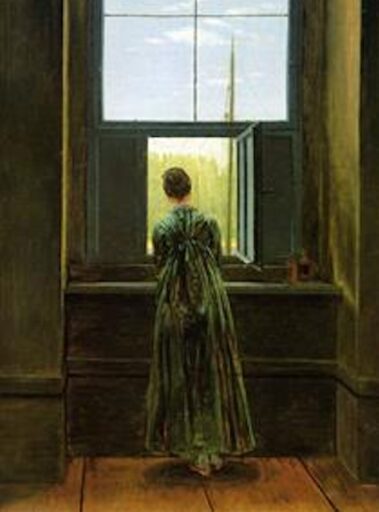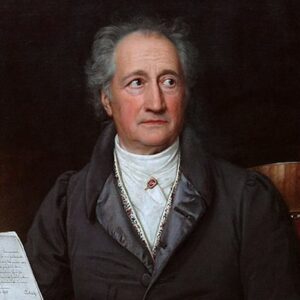I was driving through Saxony with a dear friend of mine. We had dared to visit Chemnitz together on a whim. I wanted to see a place in East Germany that still feels a little like it might have in the days before the Berlin Wall came down. A Serbian psychoanalyst we’d met at the Berlin Opera said Chemnitz. Chemnitz, he said, you have to go to Chemnitz. So we did.
There is a giant sculpted head of Karl Marx still sitting prominently in front of a Soviet-style apartment building in the middle of Chemnitz. The head is larger than you’d reasonably expect any head to be, even the head of Marx. I read a quote from the sculptor in which he was asked why he only sculpted a head, no body. Well, think about it, the sculptor answered, does Karl Marx really need arms, legs, a body? No. This is a man who was always just one big head.
The road from Chemnitz to Dresden was a drive through Caspar David Friedrich’s country. These are the hills and valleys and towns and landscapes that Friedrich painted frequently. Not exclusively. He also liked to travel and to paint from his travels. But the places around Dresden seem especially Friedrichian, to coin a term. Especially if you’ve looked at a lot of Friedrich’s paintings.
The next morning, just outside of Dresden, there was a thick fog sitting over the Elbe River. Caspar would have wanted this, I thought. He was a man who loved his fog, preferably in the cemetery, but elsewhere too, on rivers and fields, on water.
One of the bridges in the city is out, my friend Miriam said, suddenly. What do you mean ‘out’ I asked. It got washed away in the flood. There’s a flood here. Some kind of extreme rain farther east. The water is coming here now.
Later, when the fog lifted, we could see the river flowing far above its banks. We could see the trees that were once on dry paths now in many feet of water. Okay, I thought. We’ve had the fog and now we have the apocalypse. We really are in Caspar David Friedrich country.
Heading down to the city we saw the collapsed bridge. One section of it just sort of broke in two and collapsed. It is hard to look at a bridge collapsed in Dresden without also thinking of the fire-bombing of Dresden in February of 1945 and also it is hard, when thinking about that, not to think of Kurt Vonnegut hiding out in the cellar of a slaughterhouse, the eponymous slaughterhouse 5, as a prisoner of war at just that same moment that the Allies dropped their 4000 tons or so of high-explosive bombs and incendiary devices. “The Dresden atrocity,” Vonnegut once wrote in his very Vonneguty way of writing about such things, “tremendously expensive and meticulously planned, was so meaningless, finally, that only one person on the entire planet got any benefit from it. I am that person.”
The nice old town of Dresden has been restored and rebuilt since then. Personally, I like how the new stones look new and the old dirty almost black stones were allowed to look old. You can, therefore, easily see what’s new and what’s old on the faces of the buildings. It’s the right way to do it. But it makes the buildings look beat-up and pock-marked and sad. Which is, also, as mentioned, the right way to do it.
There was a quite extensive exhibit of Caspar David Friedrich paintings at the Albertinum, one of the art museums in Dresden. One has the feeling that there is always a Caspar David Friedrich exhibit at one of the art museums of Dresden. Nonetheless I was glad for it. I was glad to move slowly from one canvas to the next and to see more Friedrich paintings in one location than I had ever seen before. To see something of the, I don’t know how to describe it exactly, but the unforgiving spirituality of some of those paintings. You could call it mystical realism, if you were so inclined.
I spent time enjoying Friedrich’s famous Rückenfiguren. These are the figures that Friedrich painted from the back. We don’t see their faces. We see them from behind as they look out at whatever scene is in front of them. So, these particular paintings by Friedrich always contain a double seeing. The person in the painting is experiencing something and then we are experiencing both the scene being experienced and the person experiencing it. Amongst painters, Friedrich was notably not that interested in faces. Or better said, he understood the dangers of painting a face straight on and looking straight out. In those kinds of paintings, portraits and whatnot, the face itself becomes the experience.
But Friedrich was interested in something else. He was interested in letting his figures have their experience and then letting us have it too. Giving us the experience through our participation in the experience that is already being experienced by someone else in the picture. All that mediation returns the pictures to a second order immediacy. An earned immediacy.
I was sitting on a bench in the Albertinum, resting. And then I noticed Miriam. She was looking at one of the Rückenfiguren paintings. And I was watching her looking at the painting. I was seeing her experience, was, to some degree, having her experience. And she was having the experience of the Rückenfigur. And the Rückenfigur was experiencing the landscape. Was someone also watching me, watching Miriam, watching the Rückenfigur, watching the world? I dared not turn around. I dared not break the spell of folded, infinite, total experience, intimate and absolute all at once, and, somehow, perfectly, happening in the always wounded old town of Dresden in the flood times.
Morgan Meis has a PhD in Philosophy and is a founding member of Flux Factory, an arts collective in New York. He has written for n+1, The Believer, Harper’s Magazine, The Virginia Quarterly Review and is a contributor at The New Yorker. He won the Whiting Award for non-fiction in 2013. Morgan is also an editor at 3 Quarks Daily, and a winner of a Creative Capital | Warhol Foundation Arts Writers grant. A book of Morgan’s selected essays can be found here. His books from Slant are The Drunken Silenus. and The Fate of The Animals He can be reached at morganmeis@gmail.com.





